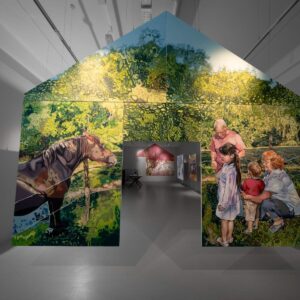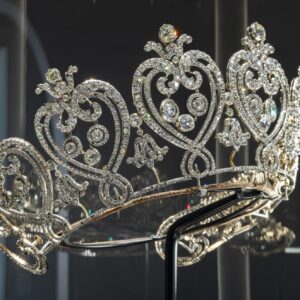
Somerset House on The Strand in London is hosting the first major exhibition to explore the phenomenon of cuteness in contemporary culture. ”CUTE: An Exhibition Exploring the Irresistible Rise of Cuteness” features works by over 50 artists. The exhibition is sponsored by Sanrio, the Japanese company that introduced Hello Kitty to the world 50 years ago, and the cute character dominates the exhibition, with a vast Hello Kitty sculpture designed by Hattie Stewart at the Embankment entrance to the exhibition, a Hello Kitty disco, and a kind of shrine to the world-famous cartoon cat in the form of 100s of plushies and Hello Kitty memorabilia from the Sanrio archives.
CUTE examines the social phenomenon of “cuteness” within contemporary culture, in particular how it can be used as a starting point for artists, creatives and brands to question gendered notions of femininity and masculinity, innocence and childhood.
Senior Curator Claire Catterall juxtaposes the Hello Kitty celebration with artworks, video games, fashion, collectibles and social media, and the exhibition is curated around five themes; Cry Baby, Play Together, Monstrous Others, Sugar-Coated Pill and Hypersonic. Throughout the exhibition contemporary artists examine or subvert the notion of cuteness, and the featured artists include; Mark Leckey, Sean-Kierre Lyons, AYA TAKANO, Mike Kelley, Karen Kilimnik, Nayland Blake, Cosima von Bonin, Hannah Diamond, Ed Fornieles, Juliana Huxtable, Rachel Maclean, Julien Ceccaldi, Paige K. B., Isaac Lythgoe, Alake Shilling, Wong Ping, Liv Preston, CFGNY, Ram Han, Maggie Lee, Bunny Rogers, Flannery Silva and Andy Holden. Also featured is the work of Somerset House Studios artists Chris Zhongtian Yuan and Sin Wai Kin Sian Fan.
Cute is undeniably the most prominent aesthetic of our times. Yet, it has only now begun to be taken seriously. Like a tiny kitten waiting to pounce, its power and influence has slowly crept up on us and today its adorable aesthetic infiltrates almost every aspect of our daily lives. But as it saturates our digitally mediated age, cuteness feeds and compels us in ways that suggest there is so much more to it than its adorable and seemingly harmless exterior might imply.
Somerset House Senior Curator Claire Catterall
CUTE features curated displays of culturally iconic objects and toys including My Little Pony, Silvanian Families, Cry Baby, E.T., Tamagotchi and Baby Yoda, as well as a computer game room and contemporary art and installations. Hannah Diamond’s immersive fruit-scented sleepover room filled with big pink floor cushions, and TV monitors showing music videos including Avril Lavigne’s ‘Hello Kitty’ promo, and Sian Fan’s interactive ‘Glimmer’ room where people can throw shapes on a sparkle-covered platform as the moves are echoed on a vast screen, were both commissioned for the exhibition.

A rainbow-coloured gallery of AI-generated Kitten prints from Graphic Thought Facility sets the tone for the fluffy cat-saturated exhibition. In a room featuring a display of cat paintings by Edwardian cat-lover and artist Louis Wain, cat photographs from the late 19th Century by Harry Pointer, and a baby pink sofa above which hands a delicate cat painting by Karen Kiliminik, there is a quote on the wall by Tim Berners Lee, inventor of the World Wide Web, who was asked to name one use of the Internet that he did not anticipate, and answered with the word ‘kittens’.
Pointer and Wain’s photography and paintings featured cats taking on human qualities and doing human things such as taking high tea, and pre-empted the cult of Hello Kitty that began in the 1970s and led to world domination, leading to internet memes and famous social media cats such as Grumpy Cat and Lil Bub. CUTE evolves into a kind of homage to Hello Kitty and a temple of associated memorabilia leading into the Hello Kitty disco room with giant glitter ball, before charting the development of the Japanese culture of ‘kawaii’ or ‘cuteness.

Artefacts from the archive of the Yayoi Museum in Tokyo including printed materials, figurines and sketchbooks explore Kawaii’s origins in the design of products from the 1910s to the 1950s. These designs were aimed at schoolgirls and young women, and depicted a romanticised notion of girlhood by incorporating Western motifs such as mushrooms and castles. The creations of several prominent female Japanese illustrators of the 1960s who challenged the innocent cuteness expressed by their male predecessors are exhibited too, including; Yumeji Takehisa, Kaichi Kobayashi, Katsudi Matsumoto, Junichi Nakahara and Rune Naito.
Since the 1990s, Kawaii (cute) has become a phenomenon associated with Japan, which gained global popularity through manga and anime characters in girls’ magazines in the early 20th century – drawn in a sentimental style inspired by European Art Nouveau – and was adapted to promote fashion, makeup and stationery and market it to young girls. The Japanese culture of Kawai could be viewed as a way of retreating from adulthood or prolonging youth. Kawai fashion is otherwise known as ‘Lolita’ fashion, and could be perceived simply as innocent dress-up and a form of self-expression referencing Victoriana. However, in Western culture there is a relation to the controversial Nabokov novel ‘Lolita’, which lends the style a more sinister undertone. Many of the girls and women who dress in Kawai fashion make their own clothes and find a sense of empowerment through creative expression, although some theorists perceive Kawaii as an aesheticization of powerlessness, believing that this form of ‘Cuteness’ isn’t just about saccharine-sweet infantile aesthetic, but can often be quite subversive.
Cultural Theorist Sianne Ngai’s ‘The Cuteness of the Avant-Garde’ – an essay included in her 2005 book ‘Our Aesthetic Categories: Zany, Cute, Interesting’ – claims that the zany, cute, and interesting form a “triad”. According to Ngai, this triad defines the way we live, with how we work being “the zany”, how we exchange information “the interesting”, and how we consume equating to “the cute”.

Ngai observed that cute objects represent an “aestheticizing of powerlessness” observing that “cute objects are usually “soft, round, and deeply associated with the infantile and feminine”. She realised that cuteness is associated with patriarchal ideas of beauty, and the faces of cute toys tend to be simplified so much that they are barely there, notably Hello Kitty who doesn’t have a mouth, or The Powerpuff Girls with their spookily large eyes. Ngai thought that their features were designed this way because any fuller personification would make them too equal to us, which would upset the power dynamic on which the cute aesthetic depends.

If taken at face value, CUTE is a pure joy-ride through the world of Kawaii, and the contemporary immersive, interactive elements coupled with the nostalgia of cute toy memorabilia offers a playful escape from reality. Kids and teenagers will love it, but adults might spot a more subversive undertone.

‘CUTE: An Exhibition Exploring the Irresistible Rise of Cuteness’, 25th January – 14th April, 2024, Somerset House







